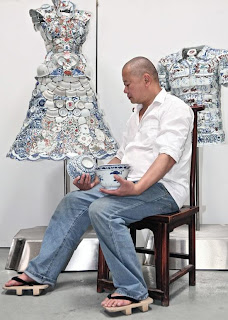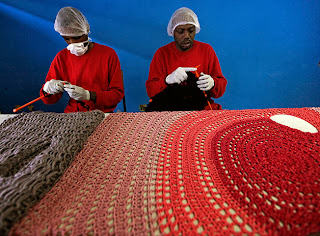Fashion
began with women being used as their husbands showgirl.
The more expensive the material and bigger the bustles on the woman, the
wealthier the man. And women had no power.
Body deforming corsetry was used to
reach unrealistic body ideals for the benefits of the men until the 1920s when
corseted dresses were abandoned for comfort and separates, as women also gained
more rights and freedom
The 60s welcomed androgynous dress,
symbolizing women's continual rise to equality.
In the modern day we now have
complete freedom as women, and freedom of choice in clothing too. But the
majority of us still choose to follow fashions, which are usually designed and
dictated by men. I disagree with this and plan to investigate what the alternatives
are.
The development of technology and its effect on the way we view clothes.
Just a few decades ago, you’d have
to save for months to afford a new item of clothing. Then you’d often alter and
patch it to keep it wearable for the rest of your life.
Now, with the introduction of fast
machines and exploitation in sweatshops, we can buy new clothes for less than
the hourly minimum wage.
Not only does this makes us
wasteful but it’s encouraging a loss of identity.
This cheap clothing is causing
people to suppress their beliefs and morals for the sake of a new outfit every
week.
For example
People who say they love children
are wearing dresses made by one, and
Those who pride themselves on
recycling buy new clothes instead of mending the ones they already have.
It’s argued that a lot of people
with less money have no choice about buying cheap.
But a good quality jumper that
costs a little bit more, will probably last ten times the length of a cheaper
alternative.
How performance art can improve the value and worth of clothing to an individual.
Performance
art in my eyes is anything from
Northampton Clown, to those critically acclaimed for it like Leigh Bowery, to
you and I dressing up at Halloween.
Wearing
different clothes makes us act differently.
Whether it’s putting on confidence in the form of a suit for work. Or wearing
your sisters top on a night out so only drinking clear drinks in case of a
spillage.
I’m looking into how performance
art can allow us to look at clothing in a new light , and what more we can get
from it than simply following a fashion.
Raquel Guimaraes
Being
proud of where our clothes come from should also
cause us to act differently
When
Brazilian fashion designer Raquel Guimaraes
struggled to find knitters for her new knitwear brand, she decided to train
inmates at a high security prison to knit for her.
By improving the inmates behavior,
prospects and reducing their sentences, she’s created a piece of clothing
that’s much more valuable. In both monetary and expressive terms.
It’s also, in my opinion, a type of
performance art due to the use of action to influence her outcome.
I believe a lot of fashion brands
are wasting their power of influence by producing visually pleasing, but
shallow, garments.
Li Xiaofeng
Li
is the opposite of shallow. He is
an appropriation artist that uses broken porcelain from ancient
archeological digs to create sculptures of clothing.
Although technically wearable, the
main aim of the sculptures is not to cover or comfort, but to tell a story.
He was commissioned by Lacoste to
reproduce his artwork onto shirts. But the story and the meaning is lost
without seeing the original porcelain.
The specific type of ceramics he
chose reflected a design only used by the upper class in the Qing Dynasty. So
the shirt represents exclusivity and wealth which is fitting.
This process of working the
un-wearable into the everyday mirrors the usual fashion process of dulling down
haute couture into high street.
It gives example of the way
production methods will change from handcrafted to mechanically produced.
The technology takes away the skill
and individuality, leaving you with something mass produced and un-original,
that you will then choose to wear to express your identity.
Creative Response
I
started thinking about how I could make clothing that explores showing personality in a visual
way
Although clothes are apparently a
method of expressing our personalities and feelings,
women often take it as their role
to stay strong and resolute at all times
A great deal of women use clothes
alongside make-up to put on a cheerful face and conceal any stress they may be
facing.
Being dressed in heavy weighted
clothing would contort the body into physically showing the strain they’re
under.
I was inspired by my mum who like
many other women, keeps any negative emotions hidden.
Each sack will be weighted, and
printed with a pattern that links to clothing from a certain time or event in
my mums life.
The weighted balls are a visual
representation of feeling emotionally dragged down.
Combining performance with clothing
will hopefully lead to a better understanding of clothing and it’s
possibilities.
Feedback:
Further investigate the clothes from my Mother and the clothes from each time period -
I've scanned in pictures of all my mothers favourite clothes throughout her life, and she's talked about different trends. But this isn't really relevant to this piece. It's more referencing to the memories behind personal pieces of clothing rather than the relation to fashions. There is no real link between any of her experiences and the time period or happenings at the time. That's why there is only a vague print or pattern. There are some hints of links between period and pattern but it's more of a personal interpretation from the clothes to the wearer rather than an obvious timeline. And to show a clear link between clothing, memories and identity.
Taper the themes down -
I plan to only touch on the three themes within a more directed argument.






































